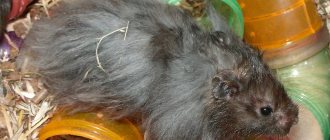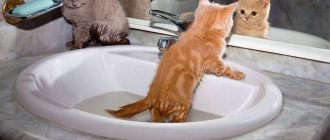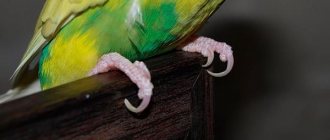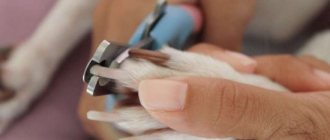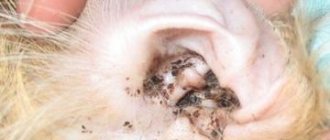- home
- Rat
- Care
07/06/2019 Monitoring the appearance of the animal is the unspoken responsibility of the owner. Many rodent owners are interested in whether it is possible to wash a rat at home. The answer is yes, but it is important to understand that this animal itself is very clean. The conditions under which a rat needs to be bathed and the details of this procedure are useful knowledge for the owner.
Do rats like to swim?
Domestic rats are descended from pasyuki. These animals are not afraid of water, but rather calmly swim in it and hunt. However, wild rats clean their fur in natural conditions using teeth or sand.
Pet rats' reactions to water depend on their temperament. Some rodents like water procedures, while others are terribly afraid and do not like to wash themselves.
Will bathing help get rid of the strong male odor?
The sebum of pet rats can be a nightmare for male owners. The lubricant produced by the sebaceous glands of rats can accumulate on them over time and produce a very strong unpleasant odor. This scent helps males mark their territory. Odorous sebum can definitely be washed off, but bathing your rat too often will only increase its production. This, in turn, will lead to an increase in the unpleasant odor. Castrating the male is the most effective way to solve this problem.
When to wash a rat and when not to
Although it is not necessary to wash the rodent, in some cases it is necessary to clean the rat's fur yourself. So, when should you carry out water treatments for a rodent?
The procedure may be needed if your rat:
- something sticky in the wool;
- wool in a toxic substance such as varnish or paint;
- a skin condition that requires a veterinarian-prescribed medicated shampoo (such as mite infestation or bacterial/fungal infections).
In other cases, washing the rat is not necessary, since it is able to clean its fur on its own. However, it is strictly forbidden to wash a rat if there are certain diseases or weather conditions.
You should not wash your rat if it has the following problems:
- wounds on the body, since upon contact with water and steaming they can become inflamed;
- the rat has a cold or has recently recovered. Water procedures can cause complications or a long recovery for your pet.
Is it possible to bathe pet rats?
First of all, it should be noted that the rat, no matter how strange it may sound, is a very clean animal. If you care for such an animal correctly, make sure that the bedding in the cage is always dry and fresh; water treatments as such are absolutely not necessary for the decorative rodent. Moreover, water, especially in combination with various detergents, washes away the natural protective fat layer from the skin of a pet, which does not have a very good effect on the condition of the coat, and sometimes can even cause the development of various dermatological diseases.
Important! Bathing for a decorative pet rat is not a prerequisite for normal keeping, but rather an exception to the rule. It is necessary to wash an animal only when it is objectively necessary for one reason or another.
It is interesting that in such situations the owner, not understanding the true cause of the problem, tries to bathe the animal even more often, which only aggravates the pathological processes. As a general rule, it is advisable to carefully wash a decorative rat only if the animal managed to get into something it shouldn’t and got really dirty. And the unpleasant odor that a pet sometimes acquires must be combated not by bathing, but by observing basic hygienic requirements for the rodent’s home.
The main thing is that under no circumstances should you leave uneaten wet food in the cage . In the process of rotting, such organic matter not only begins to smell disgusting, but also becomes a source of dangerous infections, which can then create problems for both the pet and its owner. The source of the smell can also be poor bedding in the cage. So, similar problems arise if you use sand, cut paper or sawdust for this purpose. A good solution could be pressed cat litter - it absorbs liquid and absorbs strong odors.
In addition, you need to understand that if the unpleasant smell of an animal is associated with a violation of the conditions of its detention (and this is what usually happens), after bathing the problem will only worsen - wet fur stinks even more. Having dried, the animal initially smells like shampoo, but this introduced aroma very quickly dissipates, and the situation returns to its original position. In veterinary medicine, there are no strict rules regarding the age at which pet rats should begin to be bathed, and this is absolutely understandable.
Did you know? Waterfowl rodents are found in nature: in addition to the well-known beaver, they also include nutria, muskrats (musk rats), water rats, as well as the exotic animal pacarana. However, ornamental rats are a domesticated species of the gray rat (Rattus norvegicus), and its natural habitat is in no way connected with water or swimming.
Thus, instead of looking for answers to questions about when you can bathe a rodent for the first time or how to properly teach an animal to bathe, it is better to simply follow simple rules for caring for a pet, and then there will be no need for an unnatural procedure for it.
Preparing a bath for a rat
Once you have determined that your rat needs to be bathed, you will need a few supplies, as well as preparing utensils and water before washing your pet.
The process of taking a bath for a rat is more complicated than for a person. You need to have everything ready before you start.
- Shampoo for rats.
Pet stores and online stores offer a wide range of shampoos and care products. There are products designed specifically for small rodents, and kitten shampoo is safe to use due to its sensitive formula.
- Container for the procedure.
You can use a small bowl of water (such as a bunny bowl or other shallow bowl) to bathe your rat. You can also use small saucepans. It is necessary to lay a cloth at the bottom of the container to prevent the animal from slipping.
Before the procedure, you need to let your pet get used to the bath. Allow the rat to spend time in it without water, and then fill the container to 5 cm.
- Optimal water temperature.
If you want to give your pet rat a bath for the first time, it is recommended that you do it in the summer. This way, your rat will be more likely to accept the water and see it as something positive and enjoyable.
If you can't wait until summer, use water at a temperature between 37 ºC and 38 ºC. Teach your little friend to contact with water, which should always be at a comfortable temperature.
- Towel.
You will need two large hand towels to place in the sink and drying drawer.
It is best to use pet towels such as dog towels designed for grooming.
How to wash a rat if it is afraid of water
You can accustom a rat to water only gradually and in a playful way. For example, pour water into a flat saucer and give your pet time to study it. It is also useful to wipe the animal’s fur with a sponge soaked in water, then treat it to something tasty.
The bottom line is that the pet is not afraid of water, but of unfamiliar surroundings and noise. Therefore, in case of light stains, it is better to wipe your pet’s fur coat rather than resort to a full bath. You need to accustom your pet to such hygiene in advance; it will take a lot of time.
How does the washing procedure take place?
Now that everything is set and ready, let's look at how to wash your rat.
- Remove the rat from the cage and place it in a container of water. If possible, have your pet sit on a towel at the bottom of the container. This will help your rat feel calm and prevent him from slipping.
- Then either wet the dirty areas of the fur or pour water from a small cup onto the dirty areas. Use as little water as possible.
- Now take a small amount of shampoo and gently apply it to the coat. It is important to carry out the procedure as quickly as possible to reduce stress in the rat and protect it from hypothermia.
- When you're done shampooing, take a rag or small cup and pour water over the washed coat until the shampoo is completely rinsed out.
When thinking about how to bathe your rat, it is important to avoid getting water on the face and ears. Apply water to the body, not the head or face, unless directed by your veterinarian.
- Rat head.
A rat's head should not be washed, as water may get into the ears or eyes. However, you can wipe the head and face with napkins or damp pads.
- Rat tail.
The rat tail should be cleaned separately. Wet paper towels or unscented baby wipes work well for quickly cleaning the tail.
If you decide to add a little mild soap to the paper towels, make sure the tail is thoroughly rinsed afterwards. Don't leave any soap residue.
The easiest way to wipe your tail consists of three steps:
- Hold the rat tightly to your body with one hand.
- With your other hand, wrap a towel or napkin around your ponytail.
- Swipe down. During this process, you may hear a squeak of protest, then try to calm the rat with your voice.
What to do if your animal is afraid of water
It is quite natural for a rat to be afraid of water. In part, the development of such fear can be prevented by gradually accustoming the animal to bathing, carefully monitoring the pet’s condition and not allowing it to experience a strong emotional shock from immersion in an unfamiliar substance. But in general, the animal’s attitude towards water procedures still depends on the individual characteristics of the individual.
If a rodent’s fear of bathing is simply panicky, and it is objectively necessary to wash the animal, the owner has two options:
- show firmness and bathe the rat, while trying to act as quickly as possible, calming the animal with even and gentle conversation, but at the same time without losing vigilance and not giving the animal the opportunity to escape;
- abandon water procedures in favor of wiping with a damp cloth and subsequent drying.
Which of these solutions is better - everyone decides for himself.
Drying
It is important to dry your pet completely after washing. If you skip this step, your rat may get sick.
Dry the rat with a towel until it is almost completely dry. If the weather is cool, turn the hair dryer on cool setting and low speed and dry it thoroughly. Hold the nozzle at least 30cm away from the rat's body, holding it in your other hand, and ruffle its fur to dry it.
However, the rat may be unhappy with this procedure or even afraid. Then you should offer your pet his favorite treat. Also try talking to the animal in a calm tone and calming it down. Under these conditions, washing fur can become a rat's favorite pastime.
Preparation for water procedures
To prevent bathing from being chaotic, you should prepare in advance to perform hygiene measures. This will help both owner and pet feel more confident and relaxed.
Accessories
To bathe a rat, you need to prepare the following bath accessories:
- 2 shallow basins;
- a clean towel or soft baby diaper;
- a small washcloth (you can use a small piece of foam rubber or a cloth);
- a toothbrush with soft bristles.
Some rat owners ignore the use of a special bathing container, since washing their pet under running tap water is much more convenient.
However, this approach is quite dangerous, since the likelihood of liquid getting into the furry’s ears, eyes and nose greatly increases. In addition, there are often interruptions in the water supply, and icy or, conversely, very hot water may suddenly come out of the tap.
Bathing products
It is not recommended to wash rat fur with regular shampoos. Human hygiene products are too aggressive for the delicate skin of rodents and can cause irritation or dandruff. Therefore, it is better to buy a special rat shampoo, for example:
- Beaphar;
- Veda;
- Celandine;
- Le Artis;
- Shustrik.
Such products are inexpensive - in the range from 100 to 500 rubles. Moreover, one bottle lasts for about a year. In addition, most pet shampoos for rodents contain an anti-flea and tick component.
If your nearest pet store does not have a special shampoo for rats, you can order it online. Online stores offer a wide selection of specialized products for rodents.
Water level and temperature
To make swimming comfortable, you need to take care of the water temperature in advance. Ideally, the indicator should be +36-38ᵒС. It is best to use a special water thermometer to measure temperature. If the device is not at hand, you can immerse your elbow in the basin - the liquid should be warm, but in no case hot.
The water level in the improvised bath should be 3-5 cm - it is better to focus on the size of the rat. The main criterion is that the pet must calmly reach the bottom of the container with its paws, otherwise the animal may panic and try to escape from the basin.
For the psychological comfort of the fluffy, it is recommended to install a ladder in the bath, along which the pet can, if necessary, leave the container on its own.
Some rats love water from birth and are ready to swim every day. In such cases, it is allowed to pour more liquid into the basin so that the pet can frolic to its heart’s content and swim freely. Only the owner must closely monitor the rat, and at the first signs of fatigue, pull the animal out of the water.
How to clean a guinea pig's ears
At the same time as bathing, you can clean your guinea pig's ears. Ear contamination is common in these rodents, especially in long-haired breeds. The animal cannot independently clean the ear, which is closed by long strands, so excess wax quickly accumulates in it. Over time, the pet may lose hearing; pollution also often leads to inflammation of the ear canal. Therefore, when asked whether guinea pigs’ ears need to be cleaned, veterinarians give an affirmative answer.
Buildup of wax in guinea pig ears
In order to properly perform the ear cleaning procedure, you need to do the following:
Carefully examine the animal's ear. The wax will be immediately noticeable because guinea pigs have it in the same colors as their skin. Therefore, the discharge may be yellow, black or orange, and dried crusts darken. If crusts are not visible, you can clean your ears with chlorhexidine
Dampen a cotton swab or wet wipe and gently wipe the outer ear. If the dirt is old and crusts are present, you must first drip a special lotion into the animal’s ears. You can buy it at a pet store or veterinary pharmacy. After instillation, massage your ears a little and after a few minutes wipe with a napkin.
To remove crusts from the ear, use lotion
If your pet struggles and squeaks loudly when trying to clean his ears, he may have ear infections or ear mites. Then it is better to instill appropriate drops from a veterinary pharmacy - there are drugs with universal action, with anti-tick and anti-inflammatory effects.
To reduce the likelihood of wax buildup, it is recommended to carefully trim long strands of hair blocking your ears. Also, do not forget about such a hygienic procedure as cutting nails.
Washing process
Those who have had to bathe a cat at least once in their life can be completely calm: they will have no problems washing a tailed rodent
The sequence of actions and basic precautions here are absolutely the same, but since the animal is smaller, it is much easier to deal with it
For beginners faced with the prospect of bathing a rodent, the procedure should be outlined in the form of step-by-step instructions:
Prepare everything you need in advance - a clean towel, shampoo, bath. Fill a container or two containers with warm water and make sure that its temperature is set correctly
If you don’t have a thermometer at hand, you can do this by dipping your own elbow in water: a feeling of pleasant warmth should appear on the skin. Take the rodent in your hands, bring it into the room where the bathing will take place, and close the door tightly behind you, thus cutting off all possible escape routes for the animal if the animal accidentally escapes from your hands. Carefully, but at the same time confidently, accompanying your actions with a soothing speech, plunge the animal into water up to the neck. Under no circumstances should you wet a rodent's head! Remove the pet from the water and place it on a flat surface, holding it firmly with one hand by the back close to the neck. Apply a few drops of shampoo to the animal’s back and, foaming the soap with your hands, gently lather the entire body except the head. Dip the animal into water up to the neck again and, holding the animal with one hand, thoroughly rinse the foam from the fur with the other. Remove the rat from the soapy water and immediately dip it in another container to remove any remaining shampoo.
If the animal reacts well to the procedure, rinsing can be carried out under running water, but in this case the risk of accidental burns or, conversely, hypothermia is still unreasonably high. Place the pet on a flat surface, cover it with a clean towel and wipe it gently. Dry the animal's fur with a hairdryer and only then open the door, releasing the animal into the wild.
Did you know? Gray rats are a very large
population . According to the most rough estimates, the number of these animals in the world is twice as large as people.
How often should you bathe your cat?
The frequency of bathing depends entirely on two factors: the length of the coat and the pet’s lifestyle. Cats that stay at home need water treatments much less. For such pets it is necessary to arrange a shower only in the following cases:
- Antiparasitic treatment;
- Before mating;
- If the cat gets dirty;
- During molting.
The exception is Sphynx cats, whose skin produces fat. Such pets need rinsing weekly, and sometimes more often. The frequency of washing such cats is determined by the owners as the animal gets dirty.
Outdoor cats need to be bathed more often. Even the most refined and mannered murks periodically visit the trash heap. In such places, a pet can not only become infected with all sorts of troubles. But also bring such “gifts” into the house.
This does not mean that the purr needs to be rinsed after every walk, because he himself takes care of his fur coat. However, you should not forget about swimming.
General rules
It is necessary to wash a rat at home correctly; its well-being depends on this. Before embarking on water procedures, it is worth studying the specific situations in which these measures are necessary:
- getting dirty with waste that was not removed from the cage in time;
- the appearance of any parasites on the animal’s skin or fur;
- if the pet is not eager to take care of its fur on its own;
- a few days before the exhibition.
To make the bathing process safe, you should be fully prepared for the procedure. You need to have a container with you that will be suitable for bathing, shampoo for rats or rodents and towels for drying. You should not use laundry or ordinary soap, regular or baby shampoos, since the composition there is much more aggressive than in specialized products.
If only the rat's tail is dirty, then you should not bathe it completely; it will be enough to wipe only the tail part using a damp sponge and baby cream. When planning water procedures for your pet, you should know that you cannot expose it to running water, since contact with the aquatic environment will be unexpected and extremely unpleasant for the pet, which will provoke stress and fear of such procedures.
Another danger of such bathing will be moisture getting into the ears, which the pet simply will not have time to fold properly to protect itself, as happens in nature.
Article on the topic: Names for rats, girls and boys: how to name a rodent (help in choosing a nickname)
Bath
To prevent the bathing procedure from causing panic and fear in your pet rat, it is necessary to gradually accustom it to the procedure. First of all, you should choose the right bath in which your pet will bathe. Its depth and width should be such that the rat feels confident and can get out of the container if such a desire arises. To prevent bathing from causing fear, it is initially better to accustom your pet to the bath by lowering it there for a few minutes, and when the animal gets used to it, you can gradually add water to it.
It is important not to pour a lot of water into the bath; the rat should be on its paws while bathing and calmly move around the container in any direction. If you add all the water at once, there is a risk of frightening the pet, in which it will begin to scratch and can injure both itself and its owner.
With the optimal amount of water, there is no significant risk that it will get into the eyes and ears of the animal and harm it. If the bath is overcrowded, then the possibility of incorrectly bathing the rat increases significantly.
Water temperature
In addition to the correct amount of water, you also need to monitor its temperature. This is important both for the animal’s comfort during bathing and for its subsequent health. If the parameters are incorrectly selected, the rat may become stressed during the procedure and become ill after its completion. The optimal temperature for swimming will be within 36-37 degrees.
You should not prepare two containers to bathe your pet, because the water in them will have different temperatures, which will negatively affect the condition of the animal. To avoid foaming the bath water too much, it is better to use a small amount of shampoo while lathering, so that it can be quickly and effectively rinsed off.
It is not necessary to wash a rat's face, because they themselves constantly wipe it throughout the day. By choosing the right container, accustoming the animal to it and setting the temperature correctly, you can bathe the rodent efficiently and provide it with appropriate care. Girl rats can be bathed once a month. Male rats should be subjected to this process twice or given additional wipes weekly using hypoallergenic wet wipes.
Accessories and tools
The right bath and the right water temperature are very important criteria for the bathing procedure, but accessories and means for it are also of significant importance. The rodent's body is covered with thin skin, which can be easily injured if too much force is applied. In addition, like many other similar animals, the skin has a protective layer that helps in a variety of situations and maintains normal health for the rat. If you use the wrong shampoos and washcloths, there is a risk of damaging the protective layer, and in the worst case, the skin itself.
Article on the topic: Domestic decorative rat: care and maintenance at home (photo)
It is best to bathe your rat using a small, very soft washcloth and brush. With their help, it is possible to reach all hard-to-reach places and wash them thoroughly. As for the products, you should use exclusively specialized shampoo for rodents, which is designed taking into account all the characteristics of the fur of these animals and their skin.
If you use soap or another product, you can disrupt the normal condition of the skin, which will cause irritation, itching, and affect the fur.
Bathing
To carry out the bathing procedure correctly, you must have with you:
All components are prepared in advance and tested for suitability and convenience for the rodent. If possible, you should check the water with a thermometer or dip your elbow into it. The optimal mode will be 30-35 degrees on the thermometer or the feeling of warm water, if you independently determine its temperature. About 5 cm of water is poured into the bath, and then the rat is placed there.
The bathing procedure is as follows:
- the pet’s fur must be carefully moistened, making sure that the face and ears remain dry;
- foam the shampoo on a washcloth or using your fingers, and carefully apply it to the fur, gently massaging it;
- Using a washcloth, carefully rinse off the shampoo with water from the bath.
After bathing, be sure to dry the rodent until the fur is completely dry. If a rat is afraid of water, then you should not force bathe it, this will only increase its fear. It is important to carry out preparatory measures that will allow the animal to get used to the aquatic environment and be calm in it. The owner should pour a little water into a saucer or other spacious low container so that the animal can run freely in such conditions.
After playing, it is very important to treat the rat with his favorite treat, which should also be given at first after each bath.
Drying
The drying process is no less important than the bathing itself, because the pet’s health depends on it. If you don't dry your rat's fur or dry it poorly, it may catch a cold. When planning water treatments, it is important to check the room for drafts and, if possible, eliminate them in order to protect the animal. When preparing for a swim, you should have at least two paper towels and one soft cloth towel with you.
Article on the topic: Cage for rats: rules for selection and arrangement (photo)
With the help of paper products, it is possible to quickly remove the bulk of the water that remains on the wool after bathing. Once the excess has been removed, you need to wrap the animal in a cloth towel and keep it there until it is completely dry. There is no need to rub the fur; this will be unpleasant for the rodent and can harm its skin or protective covering.
To ensure that your pet sits quietly after bathing and does not struggle, you should treat him with something tasty and talk in a soft voice, calming him down. Having endured several such procedures, the rat gradually gets used to it and is more peaceful about such care, which significantly speeds up and makes the task easier for the owner.
Let's look at it in more detail
Cases when you can bathe this rodent:
- the rat ate something inedible and subsequently got dirty in it.
- from lying for a long time on a bedding that is no longer fresh, the pet smells unpleasant.
- the rat does not clean itself, does not wash itself, is unkempt (although this is rare, it can still happen)
- if the rat has parasites.
- The animal is already old, it is difficult for him to take care of himself, or due to illness.
- found in males: the rat's tail is unkempt.
- There are rats that simply love water treatments.
Grooming in rats
Grooming is the interaction between rodents in a flock. Licking and biting each other helps keep the coat clean and improves blood circulation.
Attention. At home, you can comb your rat using a special comb or a brush with soft bristles. It would be better to cut the handle so that the animal is not distracted.
This procedure calms pets, as it resembles gentle maternal care and licking of fellow pets. It is especially useful to comb a pet who lives alone.
When should you not bathe?
There are also contraindications in which water procedures are prohibited, these include:
- Wounds and damage to the skin. Using shampoo causes pain and irritation. There is always a risk of infection.
- If you have respiratory diseases. If your rat is sneezing, has nasal discharge, is lethargic and doesn't feel well, bathing will only make the situation worse and there may be complications.
Of course, in the presence of diseases, including chronic ones, consultation with a veterinarian is always required.
When should you bathe your pet?
Experienced rat breeders believe that bathing can harm your pet only if safety measures are neglected or the procedure is abused.
It should be washed in the following cases:
- the presence of contaminants on the fur that are hazardous to health if swallowed;
- unkempt appearance, while the age of the rat does not allow it to take care of itself on its own;
- staying in an uncleaned cage for a long time;
- before the exhibition;
- when removing parasites.
In other cases, bathing your pet is not necessary. It will clean the dirt itself.
Pet rats often catch colds, so drafts and cold water are not allowed during the procedure. If fluid gets into the ears, there is a risk of developing otitis media. After washing, the wool should be dried thoroughly.
Interesting! Rats typically fold their ears when diving voluntarily. In the event of an unexpected spill of liquid, the animal does not have time to react.
You can bathe your pet no more than 2 times a month, since detergents disrupt skin functions and cause itching and dryness.
Rats can be restless in water. This will lead to a violation of security measures. In this case, it is better to remove dirt using a special comb or cotton pad.
The pet will like brushing and will evoke pleasant associations: maternal care, attention from fellow tribesmen. For wet treatment, the swab is moistened with water and carefully passed over the animal’s fur.
How to wash your dog if you run out of shampoo
It also happens that the special shampoo for dogs has run out, and the pet urgently needs to be washed. No need to grab soap and shampoo for people! For such emergencies, proven home recipes are suitable. The ingredients for these recipes are quite simple and can be found in every home.
Homemade natural recipes
Recipe 1
The shampoo has antibacterial and deodorizing properties.
Ingredients:
- white vinegar - 1/2 cup;
- dishwashing liquid – ¼ cup;
- warm water – 2 glasses.
Mix all ingredients in a spray can and shake well to mix. Wet your dog's fur and apply the resulting product evenly, whipping up a thick foam. Rinse your dog's coat thoroughly and dry it.
Recipe 2
The shampoo is recommended for pets with dry and sensitive skin.
Ingredients:
- oatmeal – 1 cup;
- baking soda – 1/2 cup;
- warm water – 1 liter.
Grind the oatmeal in a coffee grinder until it becomes flour. Pour it into a deep bowl and mix with soda. Pour in water and mix well. Wet your dog's coat and apply homemade shampoo evenly. Leave it on for a few minutes, then rinse off with warm water. Dry the coat thoroughly.
Is it possible to wash a dog with baby shampoo?
It is known that baby bath products have a softer and more gentle formula, so we can assume that it is allowed to wash dogs with baby shampoo. In fact, you don't need to do this! Such bathing can lead to itching and dandruff in your pet. If there is no special “dog” remedy, it is better to refer to our home recipes.
Do they like to swim?
We all know that in natural conditions rats show themselves to be excellent swimmers, but domesticated animals have nothing in common with these characteristics. Fluffy pets, on the contrary, are afraid of water, no matter how strange it may be, they experience great stress and fear while bathing. Therefore, experienced breeders recommend introducing rodents to water at an early age so that they perceive this procedure normally.
If we return to wild relatives who have excellent swimming abilities, there are some more points worth noting. They are excellent divers, can stay in water for up to 3 days, and also hunt underwater. But at the same time, they never use water for hygiene purposes.
They take care of themselves with the help of their paws and teeth, and also use sand as baths. Therefore, even in the wild, beautiful swimmers will not climb into the water unless absolutely necessary. Of course, there are individuals who simply love water, they are also found among pets, but there are much fewer of them who cannot stand it.
In many ways, the bathing procedure, as well as the frequency, depends directly on the owners. If they keep the animal in normal conditions, carry out regular cleaning and provide proper care, then there is no need for water procedures.
But remember, if the need for bathing does arise, this process must be approached very seriously and responsibly so as not to cause stress in the animal and harm its health.
Swimming as fun
In case of danger, the ornamental rat, like its wild counterpart, is capable of saving its life by moving through the water, but long swims do not bring particular pleasure to pets. However, according to the observations of scientists and experienced breeders, some individuals living at home willingly splash in basins filled with water.
An owner who considers it necessary to arouse his pet’s interest in bathing should choose a container that is convenient for the rat. Basins or bowls are suitable for this; you can also purchase special baths.
The pool in which a pet rat will splash must meet the following conditions:
- optimal depth so that the pet can get out of the bath at his own request; sustainability;
- size – it is desirable that the pool is 2 times larger than the rodent itself;
- walls - they must be rough, otherwise the pet may slip; devices - a rubber mat should be placed on the bottom, and a ramp or ladder should be installed at the sides.
For bathing, you must use only clean water: tap, bottled or filtered. The temperature should be determined by the comfort of the human hand.
Excessive cold can cause inflammatory diseases in the animal, hot liquid can cause burns.
It is absolutely forbidden to force your pet to swim or dive. To develop interest, it must be lured with treats. Curiosity and a craving for tasty things will prevail over natural caution, and in the summer the rodent will happily splash around in its own bath.
Washing a rodent at home
So, if there is still a need to carry out water procedures, you should do everything possible to make the animal feel safe and not panic. Be prepared for the fact that he will not sit quietly and enjoy being “bullied”; he can easily injure his owner and himself. It is also worth remembering that it is forbidden to bathe them more than 2 times a month.
Owners should remember:
- These rodents have very weak ENT organs, which leads to frequent diseases, so any drafts should be excluded when the fur is wet.
- If the temperature is not warm enough, the apartment is cold, the owners did not dry the fur coat completely and released the animal, all these factors can cause illness.
- Water getting into the ear can lead to the development of otitis media, and without timely and proper treatment, deafness.
- The use of water and shampoo is a violation of the correct life cycle, the fact is that their individual smell disappears, in addition, the protective functions of the skin are disrupted, the skin becomes dry, and this can cause the development of scabies.
After such water tests, be sure to pamper your pet with his favorite treats.
The sequence of actions of the rat bathing process itself
To prevent panic from bathing, it is necessary to wash a decorative rat in a container filled with water, but no more than 4-5 cm. To initially wet the fur, withers and back of the pet, use water collected directly in the palm of your hand. Then, using previously soapy hands or a special washcloth, rub and clean the fur, belly and tail. However, the soap should not touch the pet's ears, and the rat's face should only be lightly moistened with water.
Afterwards, the decorative rat is slowly washed with clean water and dried first with a paper towel, and then wrapped in a cloth for further drying.


